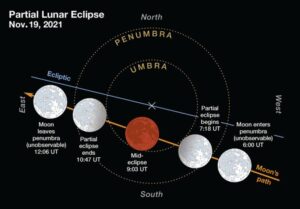Heads up for this spectacular lunar eclipse in the pre-dawn hours of Nov 19, 2021. Lasting 6 hours, it’ll be the longest lunar eclipse in almost 600 years. Expect excellent visibility all across North and South America, much of Asia, and parts of Europe and west Africa. During the period of maximum eclipse, the Moon may appear a deep red color.
In North America, the period of maximum eclipse will be right around 4:00 a.m. EST, with almost 2 hours of partial eclipse before and after that.
More below, from Space.com.
Beaver Moon lunar eclipse 2021: When, where and how to see it on Nov. 19
Visibility will be excellent across the Americas, much of Asia and parts of Europe and west Africa, and with the long event time you’ll have maximum opportunity to dodge clouds or crowded schedules to see the event unfold.
“Partial lunar eclipses might not be quite as spectacular as total lunar eclipses – where the moon is completely covered in Earth’s shadow – but they occur more frequently,” NASA said in a description of the eclipse. “And that just means more opportunities to witness little changes in our solar system that sometimes occur right before our eyes.”
Lunar eclipses are long events. This one will last about six hours and will peak at 4:02 a.m. EST (0902 GMT). The event will be visible from North and South America, Australia, and parts of Europe and Asia.
The moon will then arrive at the umbra, or the darker part of the shadow, at 2:18 a.m. EST (0718 GMT). Here you will get to enjoy about 3.5 hours of the moon passing through the deep shadow until it exits the umbra at 5:47 a.m. (1047 GMT). The eclipse will end at 6:03 a.m. EST (1203 GMT).
Assuming you can see the entire eclipse, the moon will have different appearances at different stages of the event. While it is in the penumbra or lighter part of the Earth’s shadow, it may be difficult for you to see anything at all, especially if you live in a light-polluted region. But as the moon moves closer to the umbra or deep shadow, it will begin to darken, turning a bit greyer than usual.
As the moon approaches the deepest part of the eclipse, the moon will likely turn a dark red or a brown region as it will be 97% eclipsed at the peak. The moon won’t be covered all the way, though, as at the point of greatest eclipse there will still be a region near the bottom of the moon (or top of the moon, if you are viewing through many kinds of telescopes) that is in full sunlight.
Depending on where you are located, you may not be able to see all of the eclipse. The entire sequence is visible for most of North and Central America, along with the far east of Asia, although extreme eastern regions of the Americas may only be able to view the eclipse before the moon exits the umbral phase.
South America will see most of the eclipse before moonset. Europe and western Africa will see some of the beginning of the eclipse, and central Asia along with the southern Pacific and Australia will see some of the eclipse around moonrise. You can find more details about your region at the NASA website.

